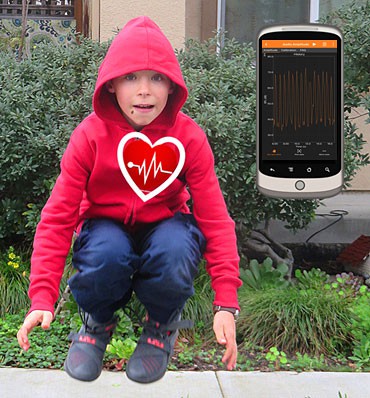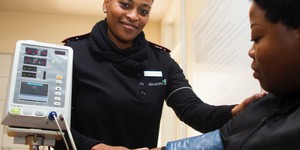Abstract
Your heart starts beating before you are born and keeps right on going through your whole life. Over an average lifetime, the human heart beats more than 2.5 billion times. Keeping your heart healthy means eating right, not smoking, and getting regular exercise. Which of your favorite physical activities give your heart the best workout and help keep it fit? In this science project, you will use a smartphone equipped with a sensor app to visualize your heart rate and find out which activity makes your heart beat faster!Summary
Edited by Sabine De Brabandere, PhD, Science Buddies

Objective
To record your heart rate during different types of physical activities.
Introduction
An average-sized adult has about 5.5 liters of blood in their body, which the heart circulates about three times every minute. Your heart is constantly beating—even before birth!—to keep the blood circulating. The heart of an average 65-year-old person has contracted more than 2.5 billion times. That is a lot of heartbeats! You can see a picture of a real human heart in Figure 1, below.
 Image Credit
Image Credit
Figure 1. A human heart.
Experts on cardiac health tell us that the best ways to keep our hearts healthy are through a balanced diet, avoiding smoking, and regular exercise. Exercise that is good for your heart should elevate your heart rate. Heart rate is a measure of how many times a person's heart beats in a minute (technically measured in beats per minute, or bpm). But by how much, for how long, and how often should your heart rate be elevated? This has to do with how fit you are and your maximum heart rate, which is 220 bpm minus your age. For example, if you are 30 years old, your maximum heart rate would be 190 bpm (since 220 minus 30 equals 190). The American Heart Association recommends that you do exercise that increases your heart rate to between 50 and 85% of your maximum heart rate. This range is your target heart rate zone. They recommend getting at least 30 minutes of moderate to vigorous exercise most days (or a total of about 150 minutes a week).
What is your resting heart rate? What types of exercises work to elevate your heart rate? How do you feel when your heart is working at 50% of its maximum rate? How about when it is working at 75% of its maximum rate? This science project will help you answer all of these questions, and help you find fun activities that are good for your heart.
Terms and Concepts
- Heart rate
- Maximum heart rate
- Target heart rate zone
- Pulse
- Resting heart rate
Questions
- What is the average maximum heart rate for someone your age?
- What is the range recommended for heart rate during exercise?
- How much exercise does your body need each week for good cardiovascular health?
- As an advanced challenge, do some research on aerobic exercise and anaerobic exercise. What are some examples of activities that provide these types of exercise?
Bibliography
- American Heart Association. (2013, Nov. 10). Target Heart Rates. Retrieved November 15, 2013.
This NOVA website has information on how the heart works and amazing heart facts:
- WGBH. (1997). Amazing Heart Facts. NOVA Online. PBS. Retrieved November 15, 2013.
- WGBH. (1997). Cut to the Heart. NOVA Online. PBS. Retrieved November 15, 2013.
For help creating graphs, try this website:
- National Center for Education Statistics, (n.d.). Create a Graph. Retrieved June 25, 2020.
Materials and Equipment
- Clock or timer that shows seconds or a helper with a watch
- Comfortable exercise clothes
- Simple and fun exercise equipment. You will want to do at least three different types of exercises, but not all of them may require equipment. Some equipment you may need includes:
- Jump rope
- Bicycle
- Hula-hoop
- 1-kg weight
- Lab notebook
- Graph paper or a graphing program
- Smartphone with a sensor app such as phyphox, available for free on Google Play for Android devices (version 4.0 or newer) or from the App Store for iOS devices (iOS 9.0 or newer).
Experimental Procedure
Familiarizing Yourself With the Sensor App
You will use a sensor app on your smartphone to record your pulse. To do this, you will make and record a sound each time you feel a pulse. If you use phyphox as your sensor app, the app recommends that you calibrate your sound sensor (audio amplitude sensor) before taking a measurements. However, in this project you are not interested in the absolute sound levels (decibel [dB] readings) but just want to see how the sound level changes when you make a sound based on your pulse. This means a calibration of the sound sensor (audio amplitude sensor) in phyphox is not necessary. If you still want to calibrate your sound sensor in phyphox, you can follow the instructions in this video to do so.Measuring Your Heart Rate
- Use the first two fingers of one hand to feel your radial pulse on the opposite wrist, as shown in Figure 2. Every time the heart pumps blood through the arteries, you can feel a change in blood pressure in the arteries. You will use the artery located on the "thumb side" of your wrist, just below the base of your hand. Practice finding your pulse until you can do it quickly. Note: Do not use your thumb, because it has its own pulse, which could throw off your count.
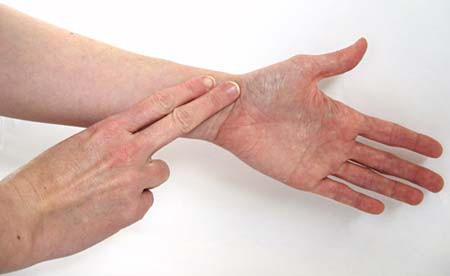 Image Credit: Teisha Rowland, Science Buddies / Science Buddies
Image Credit: Teisha Rowland, Science Buddies / Science Buddies
Figure 2. How to feel your radial pulse.
- Practice saying the word "pump" each time you feel a pulse. Can you pick up the rhythm?
- Find a quiet space. Open the sensor app and select the sound sensor (audio amplitude in phyphox). Watch the display as you repeat step 2. Do you see a peak form each time you say "pump"?
- Find the record button and record yourself saying "pump" at the rhythm of your pulse for about 20 seconds. An example is shown in Figure 3.
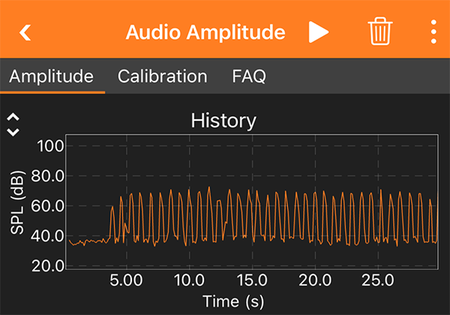 Image Credit: Sabine De Brabandere, Science Buddies / Science Buddies
Image Credit: Sabine De Brabandere, Science Buddies / Science BuddiesExample graph from phyphox records a person saying a word each time they feel their pulse. The minimum decibel level recorded was 33 dB and the maximum was 73 dB.
Figure 3. Heart beats over time. The x-axis is time in seconds [s] and the y-axis is sound intensity in decibels [dB].
- Make sure to save your data and give the recording a descriptive name. Write the date, time, and what you were doing just before you took your pulse in the name of your graph or record it in your lab notebook.
- Read the heart rate from your graph. Your heart rate is the number of beats per minute (bpm), or the number of peaks recorded in your graph over a one-minute time period. You do not have to record for a full minute to get an accurate measurement. The following procedure can help you:
- Choose a 10-seconds time interval during which your graph shows clear regular peaks. Figure 4 shows one possible choice.
- Count the number of peaks in that interval. In Figure 4, there are 14 peaks in the 10-second interval.
- You just counted the number of beats in a 10-seconds interval. What do you need to multiply this by to get the number of beats per minute? (Hint: A minute is 6 times longer than 10 seconds.)
- Perform the multiplication and you have the heart rate in bpm. For Figure 4, the heart rate is 84 bpm.
- Asses if the obtained heart rate sounds correct. A heart rate should be somewhere between 40 to 200 beats per minute.
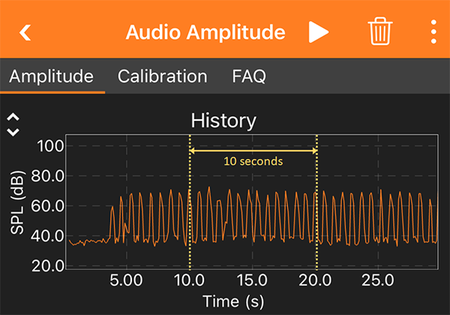 Image Credit: Sabine De Brabandere, Science Buddies / Science Buddies
Image Credit: Sabine De Brabandere, Science Buddies / Science BuddiesExample graph from Google Science Journal records a person saying a word each time they feel their pulse and marks out a 10 second section. Counting the peaks within a 10 second range and multiplying by 6 will calculate the heart rate. The minimum decibel level recorded was 33 dB and the maximum was 73 dB.
Figure 4. In your graph, count the number of peaks in a 10-second interval and multiply it by six to get the heart rate. The x-axis is time in seconds [s] and the y-axis is sound intensity in decibels [dB].
Activity and Heart Rate
- Do your background research and make sure that you are knowledgeable about the terms, concepts, and questions in the Background section.
-
Measure your resting heart rate and record it in your lab notebook, along with the date and time of the measurement. Your resting heart rate is your heart rate when you are awake but relaxed, such as when you have been sitting still for several minutes.
- Tip: It is best to take your resting heart rate at the beginning of the day, right after you have woken up but before you have gotten out of bed.
- It is a good idea to do this several times, and at different times of day, so that you can get a reliable average. You will also get an idea of the normal range of variation for your resting heart rate.
- If you want, you can calculate how many times your heart beats during a day, a month, and a year, based on your resting heart rate.
-
You will be recording your heart rate during different types of physical activity. Choose at least three different types of activities that you enjoy doing or that you think would be good exercises. You may want to choose at least one activity that you consider to be easy, and one that you think requires more effort to do. You can see some examples in Table 1.
- How do you think doing each activity will affect your heart rate? Do you think the activities will affect your heart rate differently?
| Activity | Time | |||||||||||
|---|---|---|---|---|---|---|---|---|---|---|---|---|
| 0 (rest) | 1 min | 2 min | 5 min | 10 min | 15 min | |||||||
|
beats 10 s |
bpm |
beats 10 s |
bpm |
beats 10 s |
bpm |
beats 10 s |
bpm |
beats 10 s |
bpm |
beats 10 s |
bpm | |
| Jumping rope | ||||||||||||
| Lifting a 1 kg weight | ||||||||||||
| Riding a bicycle | ||||||||||||
| Walking | ||||||||||||
| etc. | ||||||||||||
- Choose which activity you want to do. Before starting it, make sure you have been resting for a few minutes, then measure and record your resting heart rate. Your measured resting heart rate should be similar to what you measured in step 2.
-
Perform the activity for 15 minutes. After 1, 2, 5, 10, and 15 minutes of activity, stop briefly to record your heart rate with the sensor app. Once you are done with this activity, you will have five graphs for this activity. Do not forget to:
- Create a clear title for your recordings. "Running - 1 min." is an example of a clear title.
- Record how you feel in the notes of the last graph just after you finish 15 minutes of the activity.
- Look back at your graphs and count the number of beats in a 10 second interval for the graphs taken after 1, 2, 5, 10, and 15 minutes of activity. Write the counts down in your table like Table 1.
- Calculate your heart rate by multiplying the number of beats you counted (in 10 seconds) by six. This is your heart rate in beats per minute (bpm).
-
Repeat steps 4–6 for at least two more different activities.
- Leave enough time between activities so that your heart rate returns to around its normal resting level.
- It may take more than one day to make measurements for all of the activities you want to try, so be sure to plan ahead so that you have enough time to collect data.
- If you have time, repeat the measurements on each activity several times, and calculate the average heart rate. The results will be more reliable and you will also get an idea of the variation for your heart rate during these specific activities.
- Take a screen shot of your phone or tablet display with a graph of your resting heart rate, export the picture, and print it. Repeat for the graphs taken after 15 minutes of activity. Use these pictures to decorate your display board.
- Make line graphs of heart rate (on the y-axis, in bpm) vs. time (on the x-axis, in minutes) for each activity. Use graph paper, a spreadsheet program (like Excel), or Create a Graph. Look at each graph and compare them.
Questions
- Which activity increased your heart rate the most (highest bpm)?
- Which activity increased your heart rate the fastest (greatest slope)?
- Which activities elevated your heart rate to the target heart rate zone (50-85% of maximum heart rate, where your maximum heart rate is 220 bpm minus your age)?
- Do you notice any consistent patterns in your heart rate graphs?
Ask an Expert
Global Connections
The United Nations Sustainable Development Goals (UNSDGs) are a blueprint to achieve a better and more sustainable future for all.
Variations
- How does heart rate change with body position? Measure your heart rate while lying down, while sitting down, and while standing. What happens to your heart rate when standing on your hands?! (Rest your feet against a wall for balance, and have a helper find your pulse and measure your heart rate.)
- Repeat this experiment with more volunteers. How much variation is there among heart rates of different people? How do their heart rates generally change with different types of exercise?
- How does your heart rate change when you vary the intensity of your exercise? For this study, you will need to figure out ways to measure the intensity of your workout for the different activities. For many activities, you could use a helper with a timer to count your exercise rate. For example, your helper could count the number of jumps (or lifts, or steps) per minute (a metronome, if you have one, could also help you to keep time). If your bike has a speedometer, you can keep track of your speed. If you have access to a gym, most aerobic fitness equipment has a readout of intensity in either kcal/hour or watts, and indicators to let you see how much effort you are making as you work out. Pick two or three different levels (easy, medium, and challenging) and measure your heart rate after 5, 10, and 15 minutes of working out at that level. Do not exceed your recommended target heart rate zone while exercising (nearly 85% of your maximum heart rate). What intensity level elevates your heart rate to 50% of its maximum heart rate for each type of exercise? What intensity level elevates your heart rate to 85% of maximum?
- For another Science Buddies project on exercise physiology, see: Effects of Exercise: Changes in Carbon Dioxide Output.
Careers
If you like this project, you might enjoy exploring these related careers:
Related Links
- Science Fair Project Guide
- Other Ideas Like This
- Sports Science Project Ideas
- Science With Your Smartphone Project Ideas
- My Favorites


